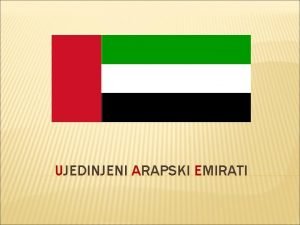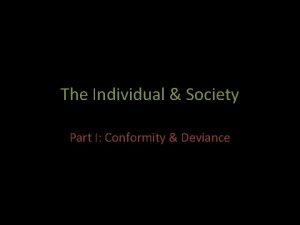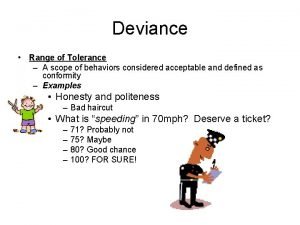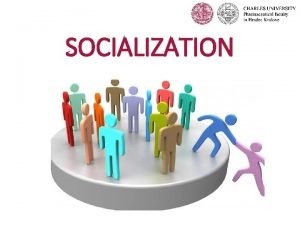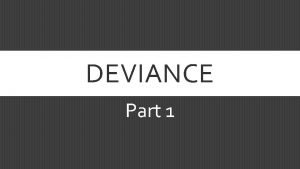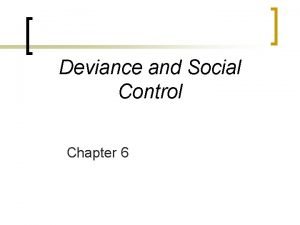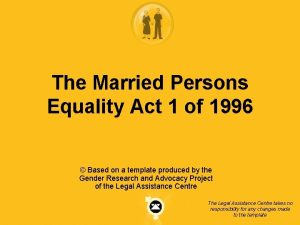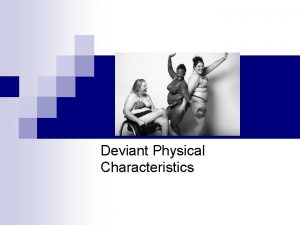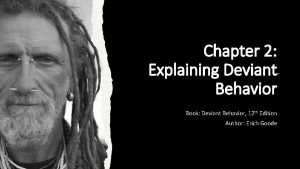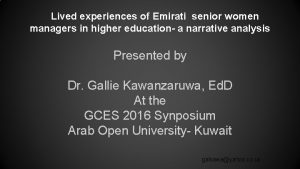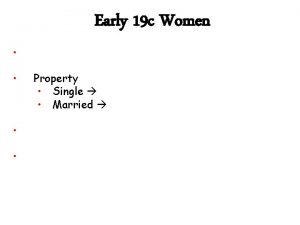A deviant choice Emirati women married to non




















- Slides: 20

A “deviant” choice Emirati women married to non. Emirati locals: a legal and anthropological perspective Dr. Leslie Vandeputte, Ms. Karoleen Molaeb, Ms. Casiana Pascariu American University in the Emirates – Dubai

Outline • Introduction • Research questions • Research methods • Analyzing the data I. Marriage in the UAE II. Women's rights in the UAE III. Emirati Women and UAE nation • Conclusion/ Recommendations

Two aspects : Research questions • What are the rights of Emirati women who married non-Emirati citizens in terms of legacy, citizenship, property transmission, etc. ? • What relationships Emirati women who married non-Emirati citizens have with their family and more broadly with the society, the culture and their country?

Research methods • 6 in-depth interviews with Emirati women (between 21 and 60 years old) • 2 in-depth interviews with Emirati males (between 22 and 38 years old) • 3 interviews with lawyers/ experts

All of our meetings and interviews looked like this. . .

Analyzing the data I. Marriage in the UAE II. Women's rights in the UAE III. Emirati Women and UAE nation

Constitution and Law : defining marriage • Under Article 7 of the constitution, UAE adopts Islam as its official religion where Islamic Sharia is the main derivation of law. • Marriage and family institutions follow the Islamic principles and laws stated under the Quran. • The Quran does not specify that a woman should marry a Muslim man, nevertheless, all schools of Islam concur that the contract is nullified if the man is non-Muslim.

“My husband was totally fine to live in Dubai. In London, it will be different. I am used to live in Dubai so it will be difficult for me to move. We totally agreed to raise our family in UAE. Our children will get citizenship and they will be Emiratis. ” Aminah, 21

Women's rights in the UAE • • Citizenship Property transmission Offsprings Socio Marital Changes

Citizenship • Updated laws • The woman still needs the approval of a male quardian, compared to an Emirati men • Very long time to receive the citizenship for their offsprings and spouses 1530 years

Property transmission • Sharia law makes the property transmission easier and clear • Western views: independent finacially from the family • Financial exclusion from imediate and extended family This Photo by Unknown author is licensed under CC BY-NC-ND.

Offsprings • Dress code • Religion • Rights and benefits of citizenship for offspring of Emirati woman married to a non-Emirati man • Legacy: pluralism and multiculturalism This Photo by Unknown author is licensed under CC BY.

Socio Marital Changes • Force dress code: abaya and shayla • No honor killing but still being disowned • Social bullying: from school to family members This Photo by Unknown author is licensed under CC BY-SA.

Emirati Women and UAE nation • UAE : a vision of a cohesive demographic structure • Promoting a sense of unity • Homogeneity vs. Heterogeneity • National and cultural identities • From a strong attachment to rejection

• "My late husband was from Bahrain. My first condition was to live in Dubai. I love my country. " Farah, 60 years old. • "Look ! she is not even local and she is wearing abaya" Enam 35 years old, quoting remarks she frequently heard • ""You do not look Emirati" , my accent, my body shape is always associated with Egyptian. " Amirah, 34 years old.

• The laws are perspicuous and UAE women whether marrying a local or non-local have equal rights to start a family. • Women did not have any conflict with the Article 47 about marriage. Results/ Conclusions • The Offspring of mixed marriages got their UAE passport sometimes it took a long time • The national dressing Abaya is considered as a strong marker of cultural and national identity. • Speaking the Arabic-Emirati dialect is considered essential in being Emirati. • Culturally, marrying a person from a different country is still perceived as "deviant", abnormal. • Having the same religion helps the family to accept the woman's decision to marry a non-national.

"My husband was more than happy to convert to Islam. Indeed, he was a Christian coming from the British descendant, but he was born in UAE. He was raised in UAE, and he wanted himself to convert to Islam. I would have not married him. " Aminah

• Easier way for the offspring (Emirati women married to non-Emirati) to receive citizenship. Recommendations • Raise awareness on anti-bullying and tolerance towards family members (especially women) who marry outside of the culture.

References • Akinci, Idil. (2019) Dressing the nation? Symbolizing Emirati national identity and boundaries through national dress, Ethnic and Racial Studies, DOI: 10. 1080/01419870. 2019. 1665697 • Khattab, A. M. (1997). Muslim Family: Idealism and Realism. In G. L. Anderson (Ed. ). The Family in Global Transition, (pp. 253Ͳ 279). Minnesota: A Professors World Peace Academy. • Al Hourani, M (2019). Lived experiences of young Emirati women in the combined family: Extending and rethinking sociological concepts in International Journal of Sociology and Anthropology, vol. 11 (3), pp. 27 -36. • Al Oraimi S (2013). The Concept of Gender in Emirati Culture: An Analytical Study of the Role of the State in Redefining Gender and Social Roles https: //onlinelibrary. wiley. com/doi/abs/10. 1111/muse. 12009 • Kemp, Linzi J (2013). Progress in female education and employment in the United Arab Emirates towards Millennium Development Goal (3) – gender equality, ” Foresight: The Journal of Future Studies, Strategic Thinking and Policy, 15(4), pp. 264 -277. • The United Arab Emirates' Government portal ( 2020). Marriage : Marriage under the UAE's law https: //u. ae/en/information-and-services/social-affairs/marriage

 Abu dhabi kontinent
Abu dhabi kontinent Ujedinjeni arapski emirati glavni grad
Ujedinjeni arapski emirati glavni grad Good choice or bad choice
Good choice or bad choice Quand le ciel est bleu mon garçon
Quand le ciel est bleu mon garçon Example of conformity deviance
Example of conformity deviance Deviant examples
Deviant examples Deviant overconformity examples
Deviant overconformity examples Formal and informal deviance
Formal and informal deviance Acts of deviance
Acts of deviance Deviant behavior examples
Deviant behavior examples What is deviance in sport
What is deviance in sport Qualitative sampling methods
Qualitative sampling methods What is deviance
What is deviance Deviant overconformity in sports
Deviant overconformity in sports Qualitative observation examples
Qualitative observation examples Definition of socialization
Definition of socialization Positive deviant
Positive deviant Cultural deviant
Cultural deviant Deviant behavior
Deviant behavior Richard ramirez
Richard ramirez Married persons equality act 1 of 1996
Married persons equality act 1 of 1996

